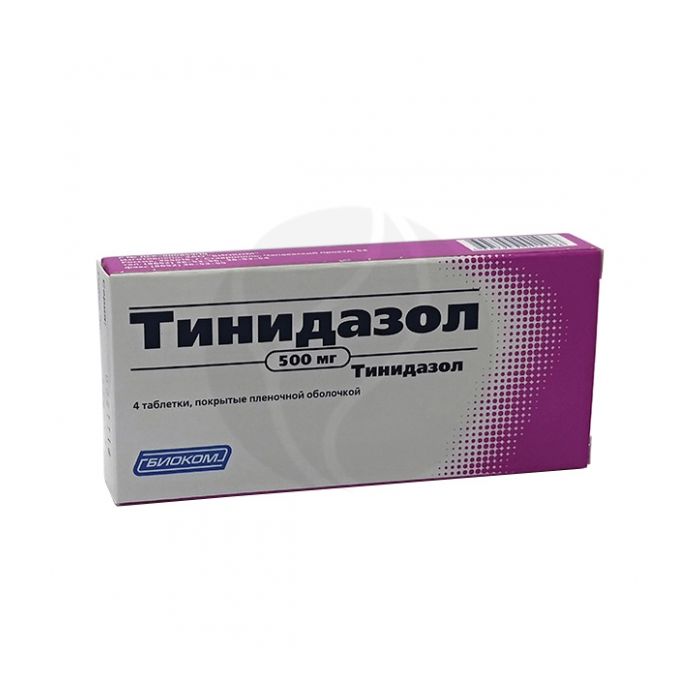Tinidazole tablets 500mg, No. 4
Expiration Date: 05/2027
Russian Pharmacy name:
Тинидазол таблетки 500мг, №4
Trichomoniasis (colpitis, endometritis, ovarian and tubovarial abscesses);
giardiasis;
amebiasis (including intestinal and hepatic forms);
infections caused by anaerobic bacteria (with pneumonia, pleural empyema, lung abscess, skin and soft tissue infections, acute ulcerative gingivitis, for the prevention of postoperative complications) and mixed infections (in combination therapy with antibiotics), eradication of Helicobacter pylori (in combination therapy with drugs bismuth and antibiotics).
Inside, during or after meals.
With trichomoniasis and giardiasis: adults - 2 g / day (4 tablets) once; children - 50Ц75 mg / kg of body weight per day. If necessary, taking the drug can be repeated at the same dose.
With intestinal amebiasis: adults - 2 g / day (table 4) for 2-3 days; children - 50-60 mg / kg of body weight per day for 3 days.
With hepatic amebiasis: adults 1.5Ц2 g / day for 3 days, if necessary - up to 6 days. The heading dose, depending on the severity of the infection, is 4.5Ц12 g; children - 50-60 mg / kg of body weight per day, for 5 days.
Treatment of anaerobic infections: for adults on the first day - 2 g / day once, then 1 g / day, for 5-6 days.
Prevention of postoperative complications: adults - 2 g once 12 hours before surgery.
The safety and efficacy of using the drug for the treatment and prevention of anaerobic infections in children under 12 years of age have not been established.
Film-coated tablets
1 tab.
tinidazole 500 mg
Hypersensitivity
organic diseases of the central nervous system;
violation of hematopoiesis,
pregnancy (I trimester),
breast-feeding.
pharmachologic effect
Antiprotozoal agent with antibacterial action. The mechanism of action is due to the inhibition of synthesis and damage to the structure of the DNA of pathogens.
Active against Trichomonas vaginalis, Entamoeba histolytica, Lamblia intestinalis. Has a bactericidal effect against the following anaerobic bacteria: Bacteroides spp. (including Bacteroides fragilis, Bacteroides melaninogenicus), Clostridium spp., Eubacterium spp., Fusobacterium spp., Peptococcus spp., Peptostreptococcus spp., Veillonella spp.
Pharmacokinetics
Tinidazole has a high degree of absorption, bioavailability is about 100%. Plasma protein binding - 12%. Cmax after oral administration of 2 g is achieved after 2 hours and is equal to 40-51 ?g / ml, after 24 hours it is 11-19 ?g / ml, after 72 hours - 1 ?g / ml. Vd - 50 liters. Penetrates the BBB and the placental barrier. It is excreted in breast milk within 72 hours after ingestion. It is metabolized in the liver with the formation of pharmacologically active hydroxylated derivatives, which inhibit the growth of anaerobic microorganisms and can enhance the effect of tinidazole. T1 / 2 - 12-14 hours. 50% is excreted in the bile, the kidneys are excreted 25% (unchanged) and 12% (in the form of metabolites) due to reabsorption in the renal tubules.
Side effect
From the digestive system: anorexia, dryness of the oral mucosa, metallic taste in the mouth, nausea, vomiting, diarrhea.
From the side of the central nervous system and peripheral nervous system: headache, dizziness, fatigue, impaired coordination of movements (including locomotor ataxia), dysarthria, peripheral neuropathy; rarely - convulsions, weakness.
Allergic reactions: urticaria, pruritus, skin rash, angioedema.
Others: transient leukopenia.
Application during pregnancy and lactation
Contraindicated for use in the first trimester of pregnancy. Application in the II and III trimesters is possible only in cases where the intended benefit to the mother outweighs the potential risk to the fetus.
If necessary, use during lactation should decide on the termination of breastfeeding. Tinidazole is determined in breast milk within 72 hours after ingestion.
Application in children
For the prevention of postoperative anaerobic infections, the dose for children under 12 years of age has not been established.
special instructions
When treating trichomoniasis, both partners should be treated simultaneously.
If adverse reactions from the central nervous system appear, tinidazole should be discontinued.
During treatment, one should refrain from drinking alcohol.
When using tinidazole, a dark coloration of urine is observed.
If treatment continues for more than 6 days, regular monitoring of the peripheral blood picture should be carried out.
For the prevention of postoperative anaerobic infections, the dose for children under 12 years of age has not been established.
Influence on the ability to drive vehicles and use mechanisms
During the period of treatment, patients should refrain from engaging in potentially hazardous activities that require increased attention and high speed of psychomotor reactions.
Drug interactions
With simultaneous use with ethanol, the development of a disulfiram-like effect cannot be excluded.

